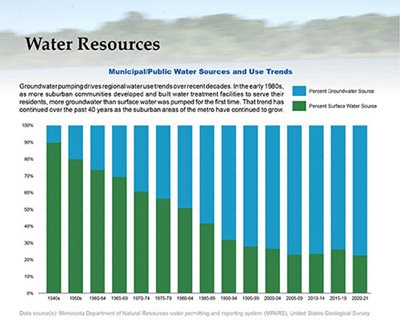The Met Council has created a new water supply planning atlas to help local government planners and elected officials make sound decisions regarding water supply quality and quantity.
 The atlas explains complex water concepts and science in an easy-to-understand and accessible format, using powerful data, maps, and graphics that both technical and nontechnical readers can understand. This new resource provides regional and local context to inform decision making, furthering the restoration and protection of water, an essential resource.
The atlas explains complex water concepts and science in an easy-to-understand and accessible format, using powerful data, maps, and graphics that both technical and nontechnical readers can understand. This new resource provides regional and local context to inform decision making, furthering the restoration and protection of water, an essential resource.
“The information in this atlas is invaluable as the Met Council facilitates subregional groups of communities, industries, and other stakeholders that are working together to address potential or ongoing water supply issues,” said Peter Lindstrom, chair of the Met Council’s Environment Committee. “It gives everyone a common base of reliable information to ground our discussions and work towards solutions to water challenges.”
Currently, the atlas is being used to facilitate conversations with regional partners that are guiding the development of the next Metropolitan Area Water Supply Plan. Regional water supply planning supports communities as they plan for the long-term sustainability of local water supplies, helping them to ensure clean and abundant water for current and future generations.
"The Met Council’s atlas provides comprehensive information on the groundwater resources in our county, and is aiding in our county Groundwater Plan update,” said Jessica Collin-Pilarski, senior planner with Washington County.
Atlas is rich in information about subregional water supplies
The atlas compiles water supply data and information from state and federal agencies, local communities, and a variety of technical studies. It also organizes information by subregions — groups of neighboring communities connected by a combination of shared water challenges and hydrogeologic landscapes. These subregions build off of water supply planning working groups organically developed during previous planning cycles. The information helps communities communicate, collaborate, and better connect with regional plans, policies, and goals.
In the atlas, find facts like:
- Nearly 70% of all water used in the region is groundwater.
- About 30% of all groundwater supplied in the metro region is used outdoors.
- Around 30% of municipal water supply is delivered to nonresidential users.
Because water supply information is always changing, with new challenges arising, the atlas will be a living document that is updated as new data becomes available and continually informed by community needs and local expertise. An update is planned for later in 2024.
View the Metropolitan Region Water Supply Planning Atlas.